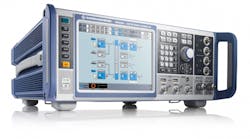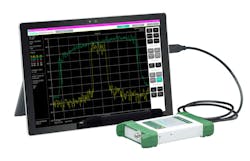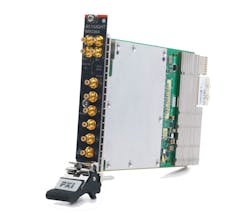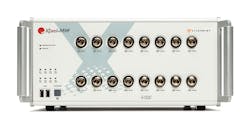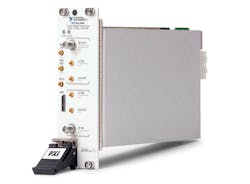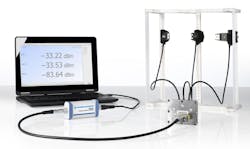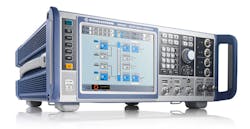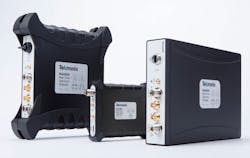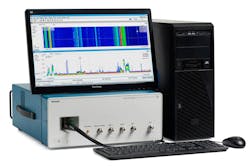Download this article in PDF format.
You’ve got to applaud the test-equipment manufacturers for their pioneering work in developing new wireless technologies. Were it not for all of their advanced work in defining new standards, test procedures, and test gear, product R&D wouldn’t be possible. If you can’t test and measure it, you can’t design it. Thankfully, the test companies are doing a great job in meeting the needs of wireless designers. Here is a look at the current trends in this area, as well as some of the latest equipment available.
Hot New Trends Influencing Test
As you probably know, the key trends motivating wireless test development are 5G cellular technology, the Internet of Things (IoT), the ever-evolving Wi-Fi, and the growing automotive market. 5G development is well under way, but the standards have not been finalized. While field trials are ongoing, there are more years still to go before we see the finished standard and initial deployments.
The primary challenges of 5G center around millimeter-wave frequencies. In the U.S., the 27-, 37-, and 39-GHz bands have been assigned. New waveforms are being defined, creating a need for a flexible signal source—not to mention, the usual vector signal analyzer. What’s required is a way to test beamforming antennas and higher degrees of MIMO in different configurations.
“When most people think of 5G, they think of the new cellular standard that will replace 4G like it replaced 3G,” says Adam Smith, director of product marketing at LitePoint. “And while the emerging 5G new radio technology (NR) won’t be in carrier trials until 2018, other 5G wireless LAN, low-powered WAN (LPWAN), and broadband wireless standards will be available in 2017—and will drive the wireless testing agenda for most manufacturers.”
As for IoT, many products in both the consumer and industrial sectors have already been developed and deployed. With IoT a work-in-progress, many more products are on the way. A wide mix of wireless technologies is being adopted. These include Bluetooth, IEEE 802.15.4, ZigBee, Z-Wave, Thread, and others. Most use the 2.4-GHz band, so readily available test gear can be used. Security testing, however, involves special requirements.
An emerging need is test gear for the new Low Power Wide Area Network (LPWAN) standards. These include LoRa, Sigfox, and the LTE-M standards for implementing cellular IoT for M2M applications. The NB-IoT standard is particularly popular.
According to Tektronix, the IoT is a primary driver in microwave and RF design today, and by extension a key driver in test-and-measurement instrumentation. With the IoT comes exponentially increasing numbers of devices from thousands of manufacturers, along with a proliferation in wireless standards and proprietary protocols (currently more than 20). There is a growing need for engineers to have RF design experience and the time-to-market windows keep shrinking. Systems are being designed and built for a broad range of products, so test instrumentation versatility is vital.
Another major trend that Tektronix sees is the “Interference of Things.” An increasingly crowded spectrum is putting new focus on spectrum management for installation, ongoing maintenance, and signal characterization tasks. In addition to a need for portable spectrum analyzers to track interferers in the field, spectrum managers also need the ability to record and analyze hours of wide bandwidth data.
Traditionally, RF experts have shared expensive high-end equipment. The reason for this is that few organizations can afford to buy more than one or two high-end instruments, and low-end signal analyzers lacked the necessary capabilities.
As for Wi-Fi, it continues to evolve. The 5-GHz 802.11ac standard is being rolled out worldwide. New products using the 60-GHz 802.11ad standard are showing up, creating a need for some really high-frequency test gear in the millimeter-wave band. The 802.11ay standard is coming, and this higher-speed upgrade to 802.11ad will require additional millimeter-wave testing.
Next in line is the new, faster 802.11ax standard. It uses high levels of MIMO to achieve super-high data rates. Smith indicated that 802.11ax represents a fundamental change in the way that Wi-Fi will operate. “Today, Wi-Fi often doesn’t have the user capacity required to deliver good wireless performance,” he says. “The major goal of 802.11ax is to service 10 times more simultaneous users without sacrificing the throughput of a connection. With 802.11ax, Wi-Fi is borrowing from cellular technology by adopting orthogonal frequency-division multiple-access (OFDMA) modulation techniques used in LTE to get more simultaneous users in the same spectrum.”
Smith goes on to say that, unlike cellular—which operates in a managed, licensed spectrum, and with a well-defined connection interchange between the mobile device and the base station—Wi-Fi operates in the unlicensed spectrum, with connections that are established on an ad hoc, on-demand basis. A successful launch of 802.11ax technology will require network infrastructure companies to manage the chaos of the unlicensed spectrum.
Verifying that these devices play by the rules of 802.11ax requires test equipment that is “packet-aware” and supports near real-time power and timing control. Additionally, 802.11ax threatens to drive significantly longer test times compared to the previous generation of 802.11ac.
Automotive applications are beginning to ramp up with the increased deployment of Advanced Driver Assisted Systems (ADAS) and self-driving car technology (with its millimeter-wave radar). The forthcoming Dedicated Short Range Communications (DSRC) technology will add vehicle-to-vehicle (V2V) and vehicle-to-infrastructure (V2I) radios in the 5-GHz band. These will begin to appear in many models beginning next year. 5G will probably play a role in vehicle-to-everything (V2X) communications systems, too.
What these trends translate into are the following guidelines, as summarized by Lawrence Wilson, a product manager for Rohde & Schwarz:
- The ability to generate and analyze wideband signals.
- The generation and analysis of digital signals at the higher microwave and millimeter-wave frequencies.
- Keeping the test cost low enough to meet the demands of each segment of wireless.
“The challenge for the wireless engineer is to get test equipment that can provide these signals quickly, accurately, and with repeatability,” says Wilson. “Engineers just do not have the time to build, manage, and maintain complex multiple box test systems. They want off-the-shelf equipment that can meet their needs. And the test solutions need to be affordable.”
“Today’s market requires test solutions that address legacy technologies, while also supporting emerging IoT and 5G verification requirements,” says Anritsu’s national sales manager, Larry Davis. “Controlling the cost of test is another key attribute. Instruments built upon flexible platforms that support current demands—and can be easily upgraded to meet emerging standards and technologies—address these conditions, so companies have confidence that their equipment can expand as their test needs evolve.”
The Latest Test Equipment Meets the Challenges
Test instrument makers are offering multiple solutions to address these trends. Here is an overview of what’s available today:
Anritsu is offering its new Bluetooth Test Sets that address the recent Bluetooth 5 low-power standard for IoT applications. Engineers developing chipsets and modules integrating Bluetooth 5 now have a comprehensive solution that can test products during the design stage. In addition, the test set can be used by manufacturers to verify the performance of products implementing Bluetooth 5, including smartphones, connectivity modules, wearables, smart-home systems, and connected-car systems.
Anritsu’s next-generation Bluetooth platforms will also perform interoperability tests on systems-on-a-chip (SoCs). One software solution adds low-energy measurement and packet-generation capability to verify that devices are operating at the new 2-Mb/s rate.
An interesting recent addition to Anritsu’s line is the MS2760A, which is claimed as the first ultra-portable millimeter-wave spectrum analyzer (Fig. 1). With its continuous coverage from 9 kHz to 110 GHz, it is ideal for the growing 5G network development market, as well as other fast-growing millimeter-wave applications like automotive radar, 802.11ad/WiGig, E-band, satellite communications, and electronic warfare (EW). The MS2760A family meets the need to test at higher frequencies while maintaining performance and affordability.
The MS2760A conducts essential measurements such as spectrum analysis, channel power, adjacent channel power, spurious emissions, and occupied bandwidth. High accuracy is achieved because the MS2760A allows measurements to be taken directly at the DUT, unlike benchtop models requiring expensive cables and mixers that can add loss and complexity.
Lower cost-of-test in high-volume manufacturing applications is also achievable using the MS2760A, as it is considerably less expensive than benchtop alternatives. Furthermore, its ultraportable size adds flexibility to production test of larger products, where test must be taken at multiple points.
Keysight Technologies is also addressing the 5G trend, as well as aerospace and defense needs, with 10 new PXIe instruments. Included are digitizers, oscilloscopes, and arbitrary waveform generators (AWGs). The digitizers and AWGs include a programmable FPGA to customize the tests. The scopes offer 200-MHz, 500-MHz, and 1-GHz bandwidths. Figure 2 shows the M9336A IQ AWG with 16-bit resolution and up to 1 GHz of modulation bandwidth.
Keysight also recently announced its latest software-centric design and test solutions for LTE-A, 5G, IoT, and connected-car technologies at Mobile World Congress in Barcelona. Examples include:
- An NB-IoT testing solution to help designers accelerate the deployment of cellular long-range IoT technology.
- A 5G wideband real-time beamforming reference solution that allows engineers to quickly and accurately test analog, digital, and hybrid beamforming systems. This includes transmit and receive massive MIMO with beamforming technology and algorithms.
- A Virtual Drive Testing (VDT) Toolset (Anite), a unique lab-based solution that helps the automotive industry cost-effectively verify wireless connectivity in the connected car. The toolset replicates drive test conditions by using field data to create test cases that are replayed in a repeatable and controllable laboratory environment.
LitePoint’s solution to wireless testing is its IQxel-MW product (Fig. 3). Designed for both R&D and high-volume production test, this 16-port instrument supports a huge range of wireless technologies. The focus is on Wi-Fi with its support for:
- Wi-Fi, 802.11ax (including multi-user MIMO and MIMO configurations up to 8×8, as well as OFDMA)
- Wi-Fi, 802.11a/af/ah/b/g/j/n/p
- Wi-Fi, 802.11ac Wave 1 and Wave 2 (including 80- and 160-MHz bandwidth combinations)
But that’s not all. The IQxel-MW can also test the following wireless technologies:
- Bluetooth, Classic/EDR (1-4.x), Low Energy (4.0, 4.1, 4.2, 5.0)
- ZigBee, Z-Wave, Wi-SUN, IEEE 802.15.4
- DECT
- TD-LTE
- Navigation: GPS, GLONASS, COMPASS
National Instruments (NI) is also addressing the trends. NI, the University of Bristol, Lund University, and one of the world’s leading providers of communications services, British Telecommunications (BT), recently announced a collaboration on massive-MIMO trials for next-generation, highly efficient 5G wireless connectivity. Massive MIMO is a crucial component of future networks, and this partnership is helping 5G become more of a reality through indoor and outdoor testing, which is key to working in real-world environments.
MIMO is already used in Wi-Fi and 4G LTE cell-phone systems, but as network capacity demands increase, there is an obvious need for more spectrum efficiency. NI and the two universities first began working together here in 2016 and set world records in 5G wireless spectral efficiency using massive MIMO. NI’s LabVIEW Communications System Design Suite, MIMO Application Framework, and SDR hardware were used for this partnership.
The NI MIMO Prototyping System is a 128-antenna, real-time, massive-MIMO testbed. Using this testbed, NI and the universities set two world records in spectral efficiency. They achieved over 79 b/s/Hz of spectral efficiency over a 20-MHz bandwidth, fully bidirectional, real-time, over-the-air link at 3.5 GHz with 12 simultaneous users. Later the team extended the system to achieve over 145 b/s/Hz of spectral efficiency, increasing the number of users to 22 sharing the same time-frequency resource.
One core product that addresses wireless test trends is NI’s second-generation PXI vector signal transceiver (VST). This combo unit offers 1 GHz of instantaneous RF bandwidth for signal generation and analysis. The PXIe-5840 VST (Fig. 4) combines a 6.5-GHz RF vector signal generator, 6.5-GHz vector signal analyzer, user-programmable Virtex-7 690T FPGA, and high-speed serial interface into a single two-slot PXIe module.
The FPGA is programmable in LabVIEW software, a feature that allows engineers to modify and customize the instrument’s firmware. The NI 5840 VST provides an upgrade to the first-generation VST in nearly every aspect, supporting a wider frequency range with a wider instantaneous bandwidth of 1 GHz.
Rohde & Schwarz is offering some interesting products for millimeter-wave testing. An example is the R&S NRPM over-the-air (OTA) power measurement solution (Fig. 5). With its frequency range of 27.5 to 75 GHz, it targets 5G as well as Wi-Fi 802.11ad and 802.11ay. The antenna modules include a diode detector. The antennas use beamforming to control the direction of radiation of the transmit antenna, thereby maximizing the power level at the receiver.
The OTA solution is designed to calibrate the transmit antenna output power and test the beamforming function. The power measurement range is 30 pW (−75 dBm) to 3 µW (−25 dBm). This instrument can implement both 2D and 3D beamforming tests and is scalable to customer needs.
Another product meeting the needs of current trends is the R&S SMW200A vector signal generator (Fig. 6). The generator comes in models with frequency ranges up to 3, 6, 12.75, 20, 31.8, and 40 GHz. It has a 2-GHz I/Q modulation bandwidth. Its extensive features support most common digital standards, such as LTE, 802.11, and even 5G air interface candidates.
Tektronix has also introduced some new products driven by the trends. An example is Tek’s line of USB-based spectrum and signal analyzers. USB-based RF test instruments possess fundamental advantages over their traditional desktop equivalents. In addition to signal-capture circuitry, desktop spectrum analyzers must also include a full personal computer, adding considerable cost and complexity to the instrument.
In contrast, the USB-based spectrum analyzer eliminates this cost from the instrument itself and simply takes advantage of the processing power sitting on every engineer’s lab bench. USB-based instruments are controlled from PC-based software, offering full real-time capture and advanced analysis capabilities in a compact package. In terms of price, organizations can now afford to buy 10 to 20 USB-based spectrum analyzers for the same price as one $50,000 or $100,000 instrument and get similar analysis capabilities.
Tektronix’s new RSA500 and RSA600 series of analyzers (Fig. 7) offer frequency coverage from 9 kHz to 7.5 GHz with 40-MHz acquisition bandwidth, a measurement dynamic range from −161 dBm/Hz displayed average noise level, and up to +30-dBm maximum input. Both work with a standard laptop via a USB 3.0 connection. The RSA500 series units target field RF measurements and are battery-powered. The RSA600 series is designed for wireless lab applications. Both instruments are based on the design of Tek’s successful RSA306 real-time spectrum analyzer. The instruments use an updated version of the SignalVu-PC software with DPX signal processing capability.
To address the needs of spectrum managers who need to capture and analyze wide bandwidth data, and designers of radar and EW communications systems and components who need to perform modulation and pulse analyses at wider bandwidth, Tektronix recently introduced its USB-based RSA7100A wideband signal analyzer (Fig. 8). It offers 800-MHz real-time capture bandwidth and up to two hours of streaming storage to internal RAID storage. It, too, uses the new DataVu-PC software.
